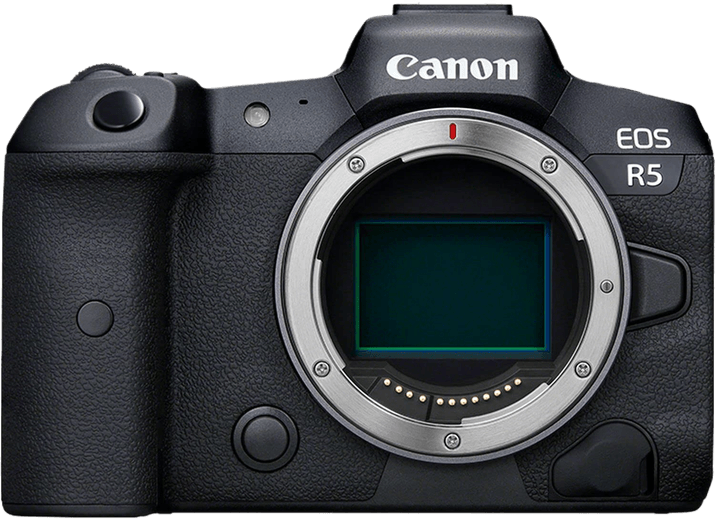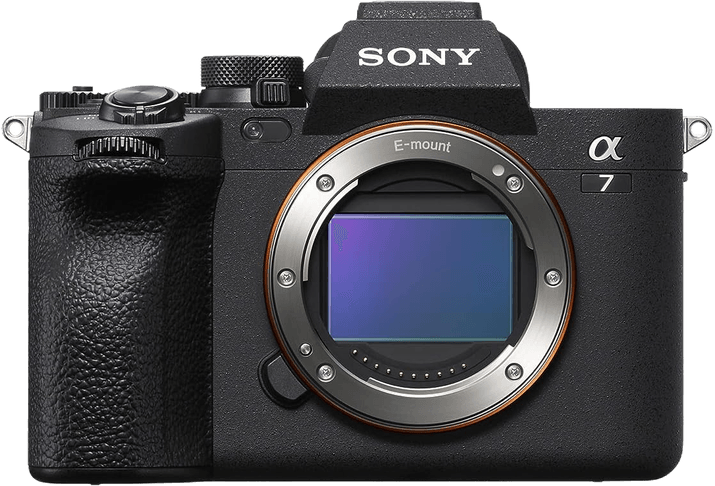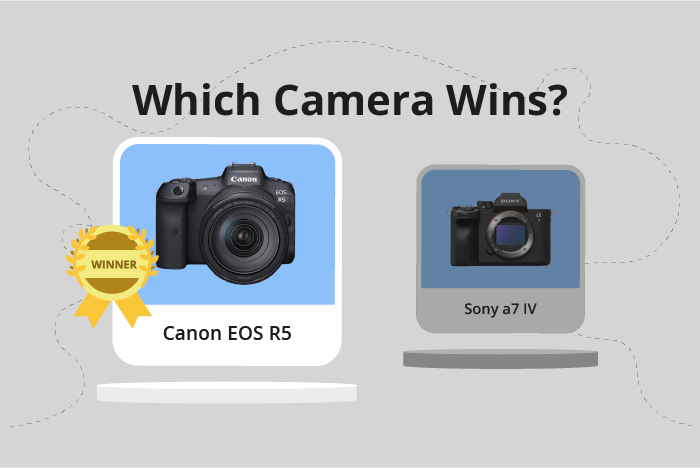Canon EOS R5 vs Sony a7 IV Comparison
Canon EOS R5

Sony a7 IV

The Canon EOS R5 outperforms the Sony a7 IV with a score of 86/100 compared to 84/100. Both cameras share similarities as mirrorless models released within a year of each other. They have comparable sizes, with the R5 measuring 138 x 98 x 88mm and the a7 IV at 131 x 96 x 80mm. The R5 is slightly heavier at 680g, while the a7 IV weighs 659g.
The R5’s higher score reveals its superior performance, likely due to factors such as image quality, autofocus, and video capabilities. However, the Sony a7 IV has an advantage in terms of cost, with a launch price of $2499, significantly lower than the R5’s $4499.
Considering the specifications and scores, the Canon EOS R5 provides better overall performance, while the Sony a7 IV offers a more budget-friendly option without compromising too much on quality.
Canon EOS R5 vs Sony a7 IV Overview and Optics
The Canon EOS R5 outperforms the Sony a7 IV in optics, scoring 88/100 compared to the Sony’s 85/100. Both cameras share some common specifications, such as the CMOS sensor type, full-frame sensor size, and image stabilization. Additionally, they both utilize their respective company’s lens mounts: the Canon RF and Sony FE.
The Canon R5 excels with its 45-megapixel resolution and a shooting speed of 20 frames per second (fps). This combination allows photographers to capture high-resolution images with rapid shooting, making it ideal for various situations, such as wildlife and sports photography. Also, the Canon R5 features the powerful Digic X processor, which contributes to its faster shooting speed and overall performance.
On the other hand, the Sony a7 IV has a lower megapixel count at 33 and a slower shooting speed of 10 fps. However, the Sony a7 IV holds an advantage with its DXOMARK sensor score of 97, compared to the Canon R5’s score of 95. This higher score indicates that the Sony a7 IV’s sensor performs slightly better in areas such as dynamic range, color depth, and low-light performance. The Sony a7 IV also uses the Bionz XR processor, which is known for its efficient processing capabilities.
Despite the Canon R5’s higher score, the Sony a7 IV remains a strong contender in the optics department due to its superior sensor performance. Ultimately, the choice between these two cameras depends on the user’s priorities and preferences. If high-resolution images and rapid shooting speeds are essential, the Canon R5 is the better choice. However, if sensor performance and image quality are the top priorities, the Sony a7 IV may be more suitable.
Canon EOS R5 vs Sony a7 IV Video Performance
The Canon EOS R5 outperforms the Sony a7 IV in video capabilities, scoring 100/100 compared to the Sony a7 IV’s 91/100. Both cameras share some common specs, such as a maximum video frame rate of 120fps and built-in time-lapse functionality. However, the Canon EOS R5 surpasses the Sony a7 IV in terms of video resolution and dimensions.
The Canon EOS R5 boasts an impressive 8K maximum video resolution, with dimensions of 8192 x 4320. This allows for incredibly detailed and high-quality video capture, making it ideal for professional videographers and filmmakers seeking the best possible image quality. The Sony a7 IV, on the other hand, offers a lower 4K maximum video resolution and dimensions of 3840 x 2160. While this is still high-quality, it does not match the exceptional resolution provided by the Canon EOS R5.
Despite the lower video resolution, the Sony a7 IV still has its merits. The camera’s 91/100 video score indicates that it is still a strong performer in the video department, and its 4K resolution is more than sufficient for most users’ needs. Furthermore, the Sony a7 IV’s lower resolution may be beneficial in certain situations, such as when users require smaller file sizes or faster processing times.
In comparing the video capabilities of the Canon EOS R5 and Sony a7 IV, the Canon EOS R5 emerges as the superior option due to its unparalleled 8K video resolution and larger dimensions. The Sony a7 IV, while still a solid performer, falls short in comparison. Ultimately, users must consider their specific needs and requirements when choosing between these two cameras, with the Canon EOS R5 best suited for those seeking the highest possible video quality.
Canon EOS R5 vs Sony a7 IV Features and Benefits
The Canon EOS R5 outperforms the Sony a7 IV in features, scoring 87/100 compared to Sony’s 83/100. Both cameras share several specifications, including a touchscreen, flip screen, absence of GPS, and the presence of WIFI and Bluetooth connectivity.
The Canon EOS R5 excels with its 3.2-inch screen size and a screen resolution of 2,100,000 dots, providing a larger and clearer display for users. These specifications make the EOS R5 more user-friendly and enhance the photographer’s ability to review and compose shots accurately.
On the other hand, the Sony a7 IV has a smaller 3-inch screen size and lower screen resolution at 1,040,000 dots. Despite this, the a7 IV still performs well and maintains its reputation as a high-quality camera. Some photographers may prefer the slightly more compact screen size, which could contribute to the camera’s portability and overall handling experience.
Considering these points, the Canon EOS R5 offers superior features with its larger screen size and higher screen resolution, which may significantly impact a photographer’s experience when using the camera. The Sony a7 IV, while not as impressive in these aspects, remains a reliable and high-performing camera. Ultimately, the choice between the two cameras depends on the individual photographer’s preferences and needs.
Canon EOS R5 vs Sony a7 IV Storage and Battery
The Sony a7 IV wins in the storage and battery category with a score of 76/100, compared to the Canon EOS R5’s score of 68/100. Both cameras have two memory card slots and support USB charging. They differ in memory cards accepted and battery life.
The Canon EOS R5 accepts SD/SDHC/SDXC (UHS-II compatible) and CFexpress cards, while the Sony a7 IV takes CFexpress Type A and SD (UHS-II compatible) cards. The Sony a7 IV outperforms the Canon EOS R5 in battery life, offering 580 shots per charge compared to the R5’s 320 shots. The Sony a7 IV uses the NP-FZ100 battery, while the Canon EOS R5 uses the LP-E6NH battery.
The Canon EOS R5’s advantage lies in its support for the faster CFexpress cards, which can benefit users who require high-speed performance. However, the Sony a7 IV offers significantly longer battery life, making it more suitable for extended shooting sessions.
Considering the differences in storage and battery capabilities, the Sony a7 IV proves to be the better choice for those prioritizing longer battery life, while the Canon EOS R5 caters to users who need fast memory card performance.
Canon EOS R5 vs Sony a7 IV – Our Verdict
Are you still undecided about which camera is right for you? Have a look at these popular comparisons that feature the Canon EOS R5 or the Sony a7 IV:

